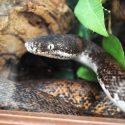
Savu Island Python Natural History
Size
They are fairly small pythons with the largest growing up to 5ft.
Habitat and Distribution
These snakes inhabit savannahs, rocky areas and forests on the island of Savu, Indonesia and can most commonly be found in rice fields and near other freshwater sources.
Age
They can live for more than 20 years in captivity.
Diet
These carnivores are constrictors, suffocating their prey by raveling themselves around the prey and squeezing. They mostly feed on small mammals such as mice and small reptiles such as lizards, swallowing them whole.
Groups and Breeding
Females lay clutches of 3-8 eggs which take around 70 days to hatch with reproduction taking place during the summer. Hatchlings are very small and have a rich orange colouration all over
Threats
The IUCN lists this species as Endangered. They are threatened by land conversion for livestock farming and ranching, hunting and trapping for the international pet trade. Unfortunately their numbers continue to decrease.
Interesting Facts
The Savu Island Python has only recently been discovered (within the last 20 years).
They are locally called the white-eyed snake due to all having very pale coloured eyes.
The Savu Island Python on your day out in Kent
Here at WWP we currently have 3 of these pythons, two females and one male. They live in our nocturnal house, which can be located through the Reptile House. They share this area alongside a number of other species, such as clouded leopards, sugar gliders and many more.
The park’s curator, Markus holds the studbook for this species. Studbook keepers are vital to the conservation of their specific species organising the movement and breeding of their animals across all collections that house them.